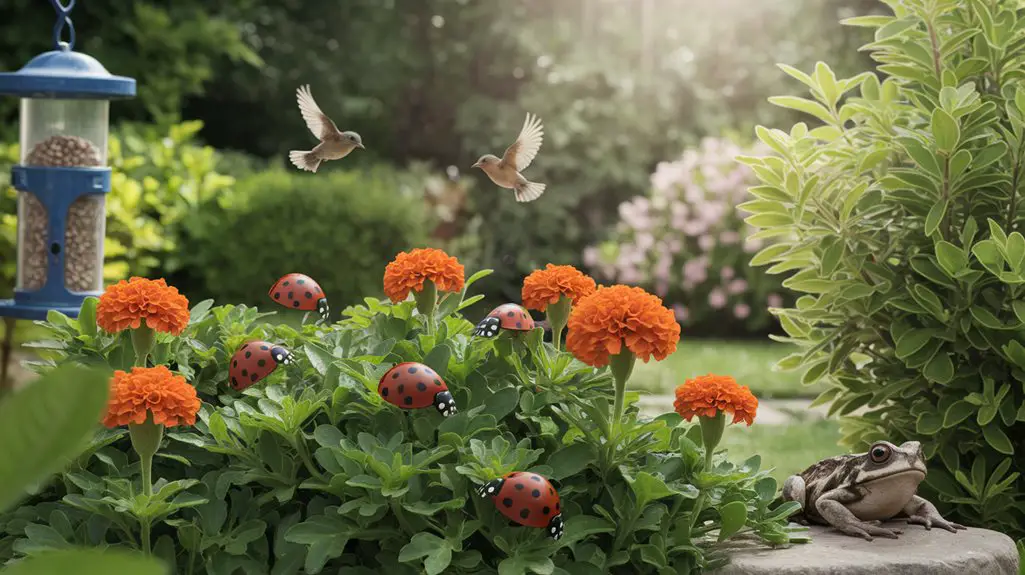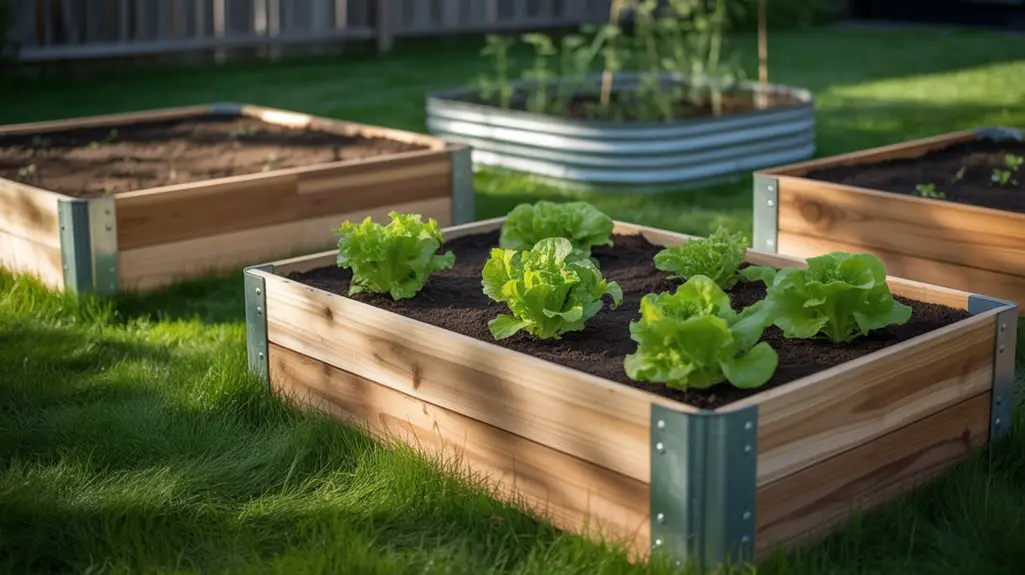You’ve likely noticed how commercial pesticides harm beneficial insects alongside pests, disrupting your garden’s natural balance. By shifting to natural pest control techniques, you’ll preserve important pollinators while effectively managing unwanted visitors. These methods work with nature’s systems rather than against them, creating a sustainable ecosystem right in your backyard. The secret lies in understanding the complex relationships between plants, insects, and their environment—connections that offer powerful solutions to your pest problems.
Understanding Common Garden Pests and Their Natural Predators
Ecosystems thrive on balance, which is essential to understand when confronting garden pests. Before reaching for chemicals, you’ll benefit from identifying which creatures are causing damage and which ones might help.
Common pests like aphids, caterpillars, and slugs target specific plants, while beneficial predators such as ladybugs, lacewings, and ground beetles naturally control these populations.
You’re witnessing ecology in action when spiders trap flying insects or parasitic wasps lay eggs in caterpillars.
To encourage this natural balance, you’ll need to provide habitat diversity. Consider planting native flowering species that attract beneficial insects, installing bird baths, and creating shelter with rock piles or insect hotels. Implementing organic pest control methods can further enhance your efforts in maintaining a healthy garden ecosystem.
Once you’ve established this ecological infrastructure, you’ll notice pest problems diminishing as predator-prey relationships regulate your garden ecosystem.
Companion Planting Strategies for Pest Deterrence

Companion planting strategically positions certain plants alongside others to naturally deter pests, creating a protective botanical network in your garden. These plant partnerships work through biochemical mechanisms, including the release of repellent compounds and attraction of beneficial insects. Implementing companion planting can enhance the effectiveness of these strategies by providing natural pest control solutions.
You’ll find greater success by implementing complementary groupings based on scientific evidence rather than folklore. Consider these proven combinations:
| Crop | Companion | Pest Deterred | Mechanism |
|---|---|---|---|
| Tomatoes | Basil | Hornworms | Masking compounds |
| Carrots | Onions | Carrot fly | Confusing scent trails |
| Brassicas | Aromatic herbs | Cabbage moths | Volatile repellents |
| Cucurbits | Nasturtiums | Aphids | Trap cropping |
Homemade Organic Sprays and Solutions

When commercial pesticides introduce harmful chemicals to your ecosystem, homemade organic sprays offer effective alternatives that maintain biological balance while targeting specific pest problems.
Mix one tablespoon of neem oil with one teaspoon of mild liquid soap and one liter of water to create a potent spray that disrupts insect hormonal systems without harming pollinators.
For fungal issues, combine one part milk with nine parts water—the naturally occurring compounds inhibit powdery mildew development.
You’ll find garlic-pepper spray particularly effective against soft-bodied insects: blend four garlic cloves and two hot peppers with water, strain, and dilute at 1:5 ratio before application.
Apply these solutions during early morning or evening hours when beneficial insects are less active, and always test on a small leaf area first to prevent phytotoxicity.
Additionally, using natural pest control methods can significantly reduce the reliance on chemical pesticides and promote a healthier garden ecosystem.
Creating Habitat for Beneficial Insects
Beyond organic sprays, a more sustainable approach involves recruiting nature’s own pest controllers to work for you.
Beneficial insects like ladybugs, lacewings, and parasitic wasps naturally prey on garden pests, creating ecological balance without chemicals.
To attract these allies, plant diverse flowering species such as yarrow, dill, and alyssum that provide nectar and pollen throughout the growing season. Additionally, creating a Pollinator Paradise can significantly enhance the presence of these helpful insects.
Include perennial plants with hollow stems where predators can overwinter, and maintain small water sources for thirsty beneficials.
Create structure by incorporating rock piles, fallen logs, and undisturbed soil areas that serve as shelter.
Avoid broad-spectrum insecticides completely, as they’ll eliminate beneficial populations alongside pests.
Remember that establishing this ecological web takes time—you’re building a functioning ecosystem rather than seeking immediate results.
Physical Barriers and Traps for Pest Management
Physical barriers represent one of the oldest and most reliable pest management strategies, creating mechanical obstacles that prevent pests from reaching your plants. Row covers, mesh screens, and copper tape effectively block flying insects, slugs, and climbing pests without chemicals.
Strategic trap placement complements these barriers. Sticky traps monitor and reduce flying insect populations, while pitfall traps capture ground-dwelling pests like beetles. For larger pests, consider humane catch-and-release traps.
The effectiveness of physical controls depends on proper timing and maintenance. Install barriers before pest emergence and inspect regularly for damage.
Unlike chemical controls, these methods target specific pests while preserving beneficial organisms. You’ll achieve superior results by combining several physical techniques within your integrated pest management strategy, adjusting based on seasonal changes and pest pressure. Additionally, using DIY traps can enhance your pest control efforts by providing targeted solutions for specific issues.
Plant-Based Repellents and Natural Deterrents
Plant-based repellents offer a complementary approach to the physical barriers discussed above.
These natural deterrents leverage compounds that certain plants produce to ward off pests through scent, taste, or chemical properties.
Companion planting with aromatic herbs like basil, mint, and rosemary can protect vulnerable crops.
Marigolds emit thiophenes that repel nematodes, while nasturtiums act as trap plants for aphids.
You’ll find that garlic and hot pepper sprays effectively deter a range of insects when applied to foliage.
Essential oils including neem, eucalyptus, and citronella provide potent pest management options.
For maximum effectiveness, you should rotate these botanical solutions to prevent pest resistance. Natural methods can also enhance the overall health of your garden ecosystem.
When properly integrated with other natural methods, plant-based repellents support a balanced ecosystem where beneficial organisms thrive while problematic pest populations remain controlled.
Conclusion
By embracing these natural pest control strategies, you’re not just protecting your garden—you’re fostering a microcosm of ecological balance where every creature plays its part. Like a well-conducted orchestra, your backyard can achieve harmony between predator and pest, plant and pollinator. You’ll enjoy healthier yields while reducing chemical inputs, contributing to broader environmental resilience, and maintaining the delicate web of life that sustains us all.




